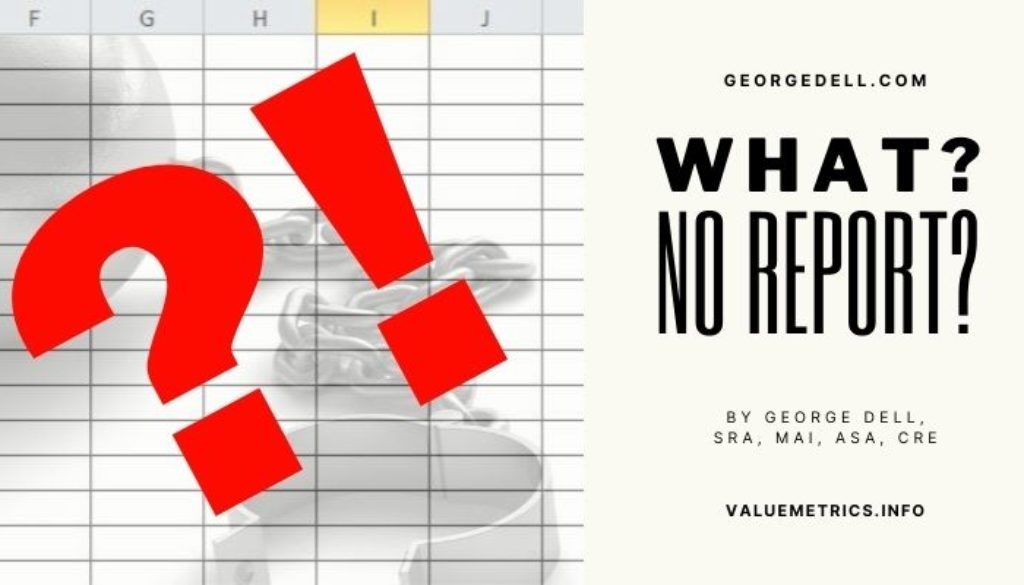No report. Can it be?
Does modernized appraisal require a modernized report? And how about non-appraiser appraisals (valuations)? (Here we use the word ‘appraisal’ in its generic public meaning.)
In the past, our thinking, expectations, laws and regulations, have separated the development of an appraisal from the report of an appraisal. In the past, that separation was easy.
The most efficient way to communicate an opinion, or ‘automated’ result, has been in two-dimensional boxes – called ‘forms’ or using the accountant’s spreadsheet cells. The fill-in boxes are to be ‘supported’ by word explanations to justify the opinion and explain the reasoning.
Automated results provide little if any explanation, but do usually provide some indication of reliability via a fsd (forecast standard deviation) or “confidence score.” A problem here is that each AVM company keeps its calculation method secret. If a result does not meet an AVM-modeler-predetermined score, it is declared a ‘no hit’ and the company declines to provide an answer. So, AVM results, and the method of ‘support’ is opaque. Nothing to ‘see-through’ here.
Opinion professionals are not required to provide explanation of reliability. In fact, the required goal is to be “credible”, defined as to be “worthy of belief.” Worthiness is the goal, not reliability.
Reports. In the past, ‘hit’ AVMs and “worthy opinions” have been fixed, static deliveries of boxes able to be data-set-filled cells, able to be printed on two-dimensional paper (even if seen on a monitor).
Reports in the future are not so restricted. We still use words, sentences, and paragraphs. But we are not restricted by boxes and cells. Not forms. Not spreadsheet cells.
The output will be a modified, enhanced data stream. Appraisers will take raw data, sort and model into useful information, then communicate results with visuals, models, and logic algorithms. The modified data stream will help prevent accusations of bias because it removes the vulnerability of ‘comp-picking.’
And how do we communicate opinions and results. The answer is: “It depends.”
It depends on who is the reader-user of the results. The ‘who’ may be a reviewer/auditor, underwriter, investor, equity enforcer, risk analyst, portfolio manager, administrator, or regulator.
Each of these users has different needs for information and understanding. Different.
A single form or static report limits usefulness. It is unnecessary. It is restricting. It is incomplete and inadequate for any given use and user. Most importantly, an assumed fixed report simply restructures the limitations of today’s cells and boxes.
Data can be standardized and coded. Analysis can only partly be standardized. Reports must take the opposite opportunity – customize and adapt interactively to the user’s needs.
Each user type will have different needs for underlying data, for modeling explanations, for visual presentation, and additional information (like “requests for reconsideration”).
Each decision-maker will be able to interrogate the algorithm interactively, dynamically.
The goal of an appraisal report is: data > information > knowledge > decision. The future ‘report’ will be called a dashboard, customized to each user’s goals, and needs. Full decision-maker software integration is the goal.
The public trust will be enhanced with useful information instead of obsolete boxes and cells. We will get out of the cell.

October 20, 2021 @ 7:17 am
Often times in litigation work, the client does not ask for or want a report. I stopped using forms the year UAD came out, and my forms program was up for renewals.
When we do write a report, it is a narrative, which might be 6-25 pages most of the time, maybe 35-40 pages if it includes three approaches to value.
I started doing this the year the SOW Rule was added to USPAPPIE. Clients lover the brevity, telling me the report is so clear.
Often times the report includes little more than a sentence or paragraph about the area and subject along with a property profile, maybe pictures, a table of appropriately selected sales and the statistics to go with them and a concluding paragraph.